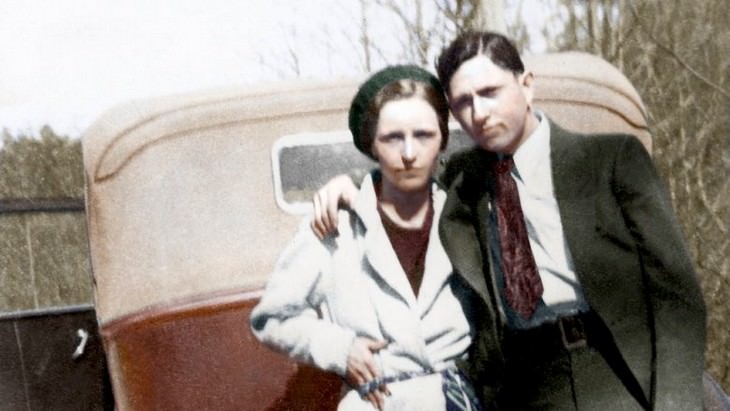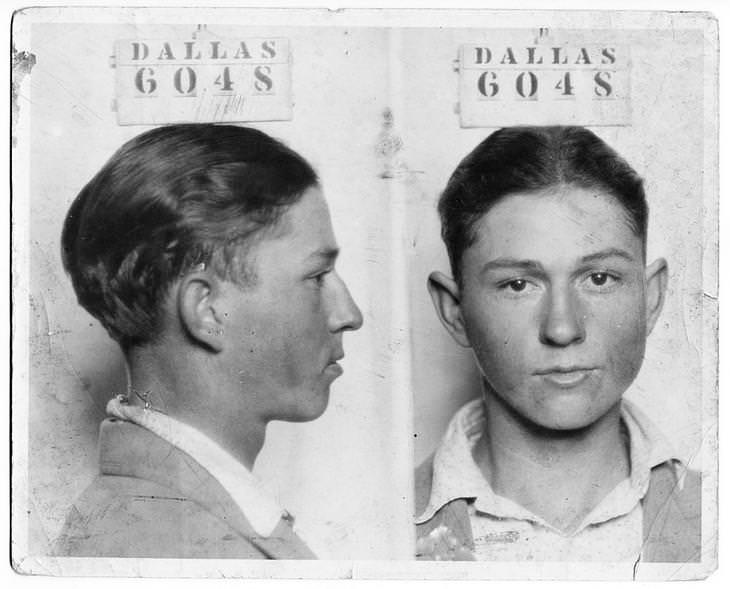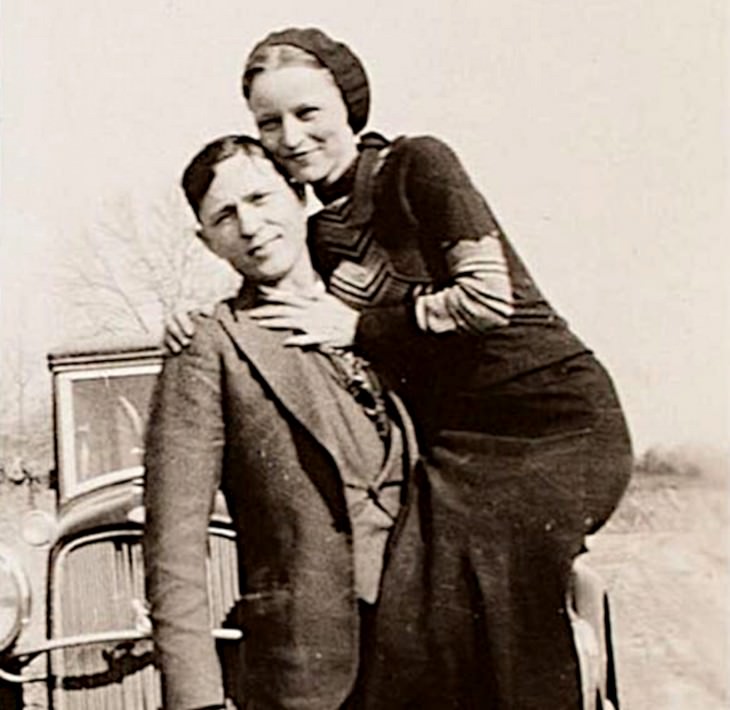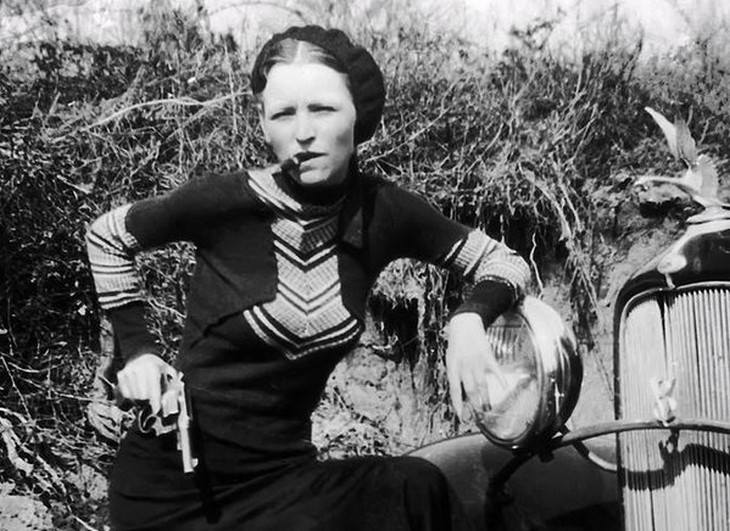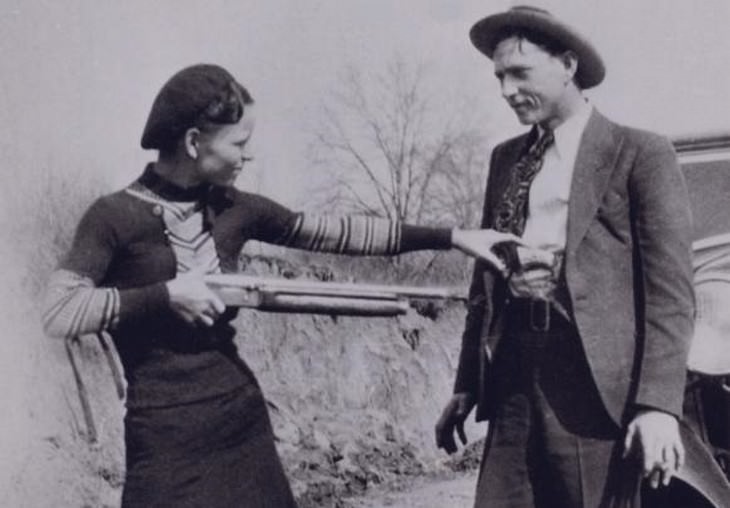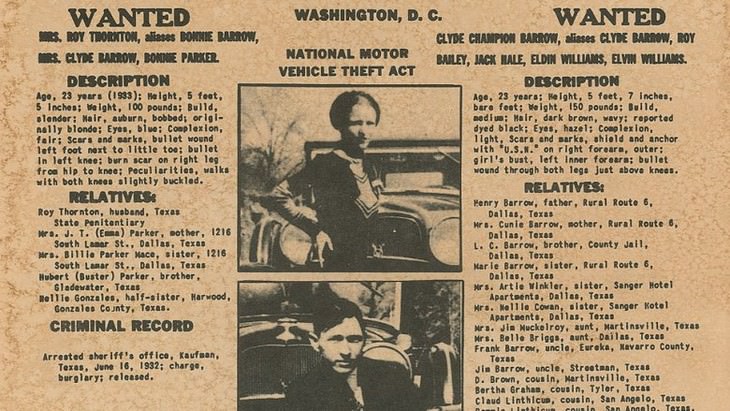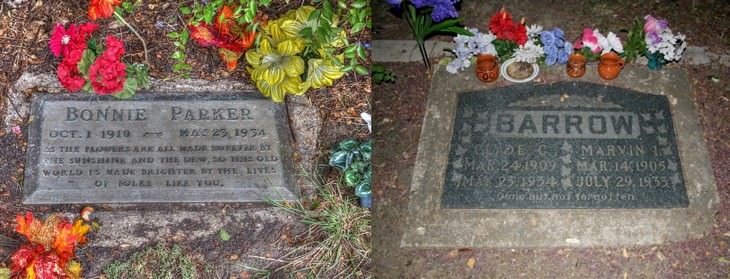1. Bonnie died a married woman... But not to Clyde
In December 1926, only six days before her 16th birthday Bonnie married her high school sweetheart Roy Thornton. The young bride even got a tattoo of their names on her right thigh to celebrate the union. However, the marriage was a tumultuous one. Thornton would disappear for long periods of time, only to come home drunk and abusive. Bonnie once referred to him as a “roaming husband with a roaming mind.”
In 1929 he was imprisoned for robbery, and he and Bonnie never saw each other again. Not long after, in January 1930 Bonnie met Clyde Barrow, who was to become her life long soulmate. Despite her new relationship, Bonnie never formally divorced her first husband. On the day Bonnie and Clyde were killed in 1934, she was still wearing Thornton’s wedding ring.
2. Clyde was already a wanted man when he met Bonnie
The budding romance was soon interrupted when 20-year-old Clyde was arrested and convicted of several criminal charges pertaining to auto theft. Despite only knowing him for several weeks at the time, lovesick Bonnie was determined to help Clyde escape.
To the dismay of her family, she smuggled a gun into prison for him, which he used to break free along with his cellmates. They were captured a year later, and this time Clyde was sentenced to 14 years of hard labor in the notoriously harsh Eastham State Farm.
3. They both had trouble walking
Both Bonnie and Clyde suffered injuries which left them with permanent impairments in their legs, which is quite problematic for people who lived their life on the run. After serving a year and a half in Eastham, Clyde decided he could no longer endure the unforgiving work and brutal living conditions of the prison.
In the hopes that an injury would have him transferred to a less harsh facility, Clyde severed his left big toe and a portion of a second toe with an ax. To this day, it is not clear if he did this to himself or had the help of a fellow inmate. The most jarring thing about this story is that self-mutilation was unnecessary. Only 6 days after the incident, his mother’s pleas to the Governor of Texas led to his release on parole.
He reunited with Bonnie as soon as he got out, and the two set out to a life of crime on the road. The injury crippled his stride for the rest of his life and forced him to drive in his socks. A year later, Bonnie was involved in an accident that left her too with a lifelong limp, thanks to Clyde driving in his socks. Clyde was known for his reckless driving, and one night in June 1933, as he was speeding through a rural road in Texas, with his wife in the passenger seat, he completely missed a detour sign warning of a bridge under construction.
The car plunged down into a dry riverbed, and the shattered car battery spurted acid all over Bonnie’s right leg. The couple had experience in nursing gunshot wounds, and the leg eventually healed but not properly, since seeing a real doctor was not an option. Bonnie spent the last year of her life hopping rather than walking, according to witnesses, and sometimes she struggled so much Clyde had to carry her.
4. Bonnie wrote poetry
Bonnie had many talents, and maybe in a different life she could have been famous for completely different reasons. During her school days Bonnie was considered a bright student who showed keen interest in poetry and literature. While she was imprisoned in 1932 for a failed hardware store burglary, Bonnie penned a collection of 10 poems which she entitled “Poetry from Life’s Other Side”.
The compilation included “The Story of Suicide Sal,” a poem about an innocent country girl lured by her boyfriend into a life of crime. Two weeks before her death, Bonnie sent her mother a poem called ‘The Trail’s End’ that finished with the verse:
Some day they’ll go down together;
And they’ll bury them side by side,
To a few, it’ll be grief—
To the law a relief—
But it’s death for Bonnie and Clyde.
Bonnie’s poems were found in the hideout, alongside the photographs which made the couple famous.
5. They didn't rob that many banks
Despite their image as Depression-era Robin Hoods, who stole from rich and powerful financial institutions, the majority of the couple’s crimes were not that grand at all. Most of their robberies were of gas stations and grocery stores, sometimes leaving with loot as small as $5. The small gain meant they had to perform robberies more often to have enough to get by, which made them easier to track.
The few successful bank robberies that were associated with Bonnie and Clyde were mostly committed by Clyde and his criminal partner Raymond Hamilton. Bonnie would sometimes drive the getaway car, but often she was not involved at all, staying in a hideout while the rest of the gang robbed the bank.
Related Article: 6 Famous Depression-Era Bank Robbers
6. Bonnie and Clyde released more people than they hurt
Bonnie and Clyde were reluctant killers. They were constantly on the run, always facing the risk that someone would spot them, report to the police, and bring forth their capture. Once cornered, Clyde chose killing over the prospect of going back to prison. 14 lawmen died during the couple’s short and violent ‘career’.
If possible, however, Clyde would abduct someone (sometimes even a cop), make a getaway, and then release the person somewhere down the line. In more than one instance, he gave the unharmed kidnapped victim money to get back home. Public opinion about Bonnie and Clyde shifted after a fatal clash with two motorcycle cops on Easter Sunday, 1934.
The couple and gang member Henry Methvin were taken by surprise after sleeping late in their car. In the commotion, Methvin misinterpreted Clyde’s words “Let’s take them”. He thought the meaning was to fire rather than kidnap them. The two policemen were E.B. Wheeler and H.D. Murphy. The latter was a rookie on his first day on the job. Murphy was also about to get married, and his heartbroken fiancee wore her wedding gown to the funeral. Once the incident made headlines, the public that often cheered for the brazen outlaws now wanted to see them caught.
7. Bonnie and Clyde were buried separately
On May 23, 1934, the spectacular manhunt came to an end. Bonnie and Clyde were ambushed by police posse led by Frank Hamer on a Louisiana road. The outlaw lovers went down together, just as Bonnie predicted in her poem, but were separated in death.
Despite their wishes, Bonnie’s mother who had disapproved of Bonnie’s relationship with Clyde, had her buried in a separate Dallas cemetery. Clyde was buried next to his brother Marvin underneath a gravestone with his hand-picked epitaph: “Gone but not forgotten”.

